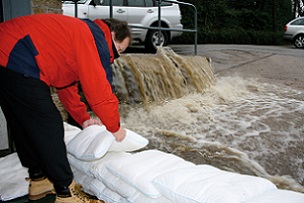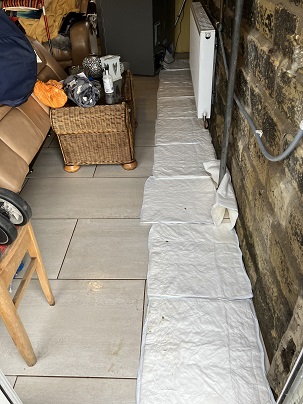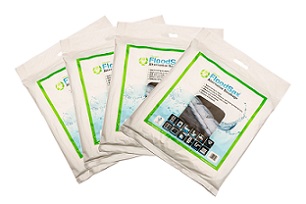 Retained Alyth Flood Team leader Grant Train
Retained Alyth Flood Team leader Grant Train
 FloodSax in action holding back a torrent of floodwater
FloodSax in action holding back a torrent of floodwater
 In their dry state FloodSax soak up water inside homes and businesses to prevent flooding and damage
In their dry state FloodSax soak up water inside homes and businesses to prevent flooding and damage
 FloodSax alternative sandbags are very space-saving to story
FloodSax alternative sandbags are very space-saving to story
How FloodSax alternative sandbags are helping to make a community emotionally scarred by flooding feel safer
A community devastated by a ‘biblical’ flood now has the world’s best-known alternative sandbags to help it prepare for future floods.
The small Scottish town of Alyth saw dozens of properties flooded and some businesses sadly shut for good after a massive flood in the summer of 2015. The east Perthshire town has a population of just 2,370 and many now have floodgates to protect their doors so a flood team set up in the town is also giving them FloodSax alternative sandbags to be used inside to soak up any water that will inevitably still seep in.
The town has now had major flood events in 2020 and 2021 along with two more last year.
The town’s Retained Alyth Flood Team (RAFT) leader Grant Train said: “This was supposedly a once in 100-year issue but is now happening multiple times a year.”
FloodSax have a unique gelling polymer inside them which absorbs water so it will soak up any water that comes into contact with them. If they are fully immersed in water the FloodSax absorbs up to 20 litres, retains it and expands to become instant sandless sandbags. This means FloodSax can also be made into protective flood barriers outside.
The FloodSax have been bought by RAFT funded by Alyth Development Trust following on from advice from the Scottish Flood Forum, a charity which advises on flood issues and supports a network of community resilience groups. The company that makes FloodSax, Environmental Defence Systems Ltd based in Huddersfield, West Yorkshire, did them at a hugely discounted price and added some extra ones in for free. It means RAFT now has 1,360 FloodSax ready for any flooding emergency either inside or outside properties.
RAFT is the first flood action group of its kind in the UK, having volunteers who are paid to be trained and will take the lead with action and advice if another flood hits the town.
Grant, 36, said: “Sandbags are so heavy, especially when wet, so they may as well not exist for vulnerable households as they would find it impossible to lift them. Around half of Alyth’s population is over 50 so FloodSax are far more manageable for them.”
The catastrophic flood in Alyth happened in July 2015 causing millions of pounds damage and was triggered by an unusual set of circumstances. The town is in a valley surrounded by hills which have had grooves gouged into them by glacial action around 20,000 years ago and little more than two metres of permeable soil layers.
This means that when it rains heavily the rain runs down the channels and pours into a burn that runs through the centre of the village before joining the river Isla. The problem on the day of the flood, July 17, 2015, is that the water burst the banks and carried away tree branches and large logs from the nearby woods that had been newly cut, along with a skip and debris from a builder’s yard. The skip became jammed under an ancient packhorse bridge, forming a dam which then sent the torrential water cascading through the town, flooding shops and other businesses along with homes.
Eventually the skip was forced under the bridge by the sheer force of the water, the water shot out the other side of the bridge with incredible force, slamming debris into anything in its path and wrecked two footbridges over the burn before a more substantial road bridge caught the debris.
RAFT now has a team of seven who are all well trained in what to do during a flooding emergency, how to prevent floods such as clearing debris from the burn and are drawing up a robust flood plan for the future. They are also trained in first aid, the hazards of cold-water immersion, flood planning and how to use a radio network.
Grant said: “Everyone rallied round during the 2015 flood to try to save whatever they could, but some crazy dangerous things went on such as someone being dangled over the bridge on a chain to try to clear the debris. It’s a wonder no-one was hurt or killed.
“Now we have a dedicated and trained flood team it makes things a lot safer. What happened that day has made people living in Alyth, especially those close to the burn, very nervous about flooding and they have a fear it could happen again. That’s why it’s so important people have what they need so they feel they are ready.
“It’s no exaggeration to say they are emotionally scarred by the events of July 2015. There is a lot of passion and tension about flooding in this town.”
RAFT has received funding from the National Lottery and Perth and Kinross Council. This means the team now has a shipping container with equipment in it needed to deal with a flood.
There are also sensors in the burn higher up the valley so the group will have a maximum of 40 minutes warning if the water is suddenly rising to potentially dangerous levels, but consistent preparation and solid planning and drilling give the advantage to the responders.